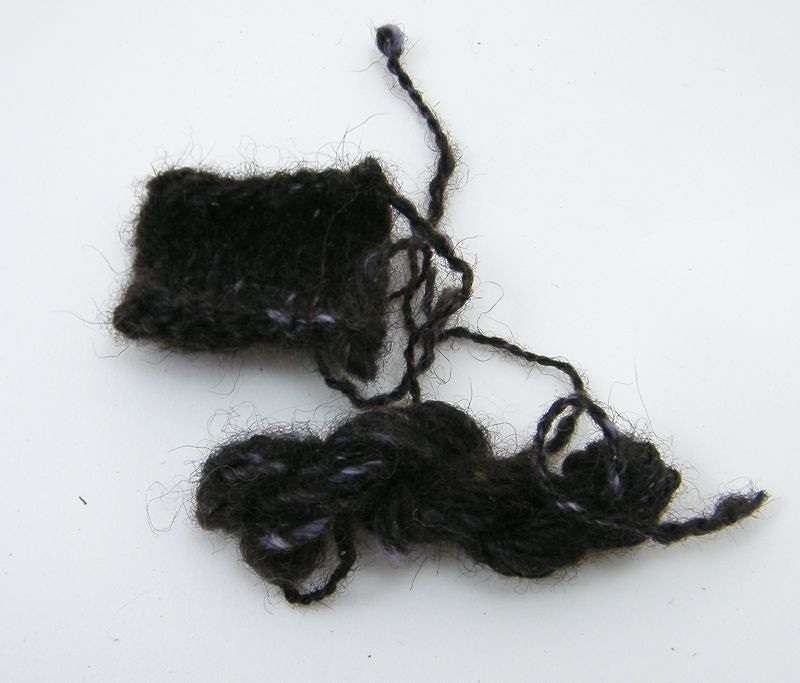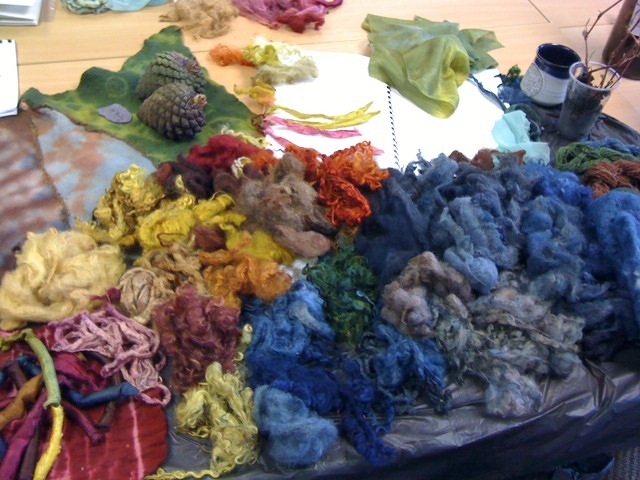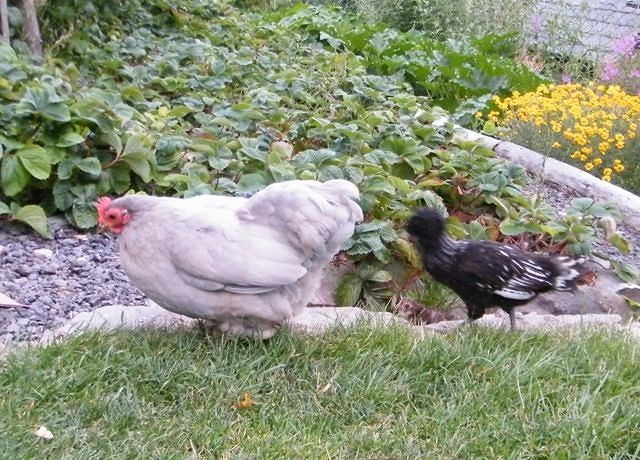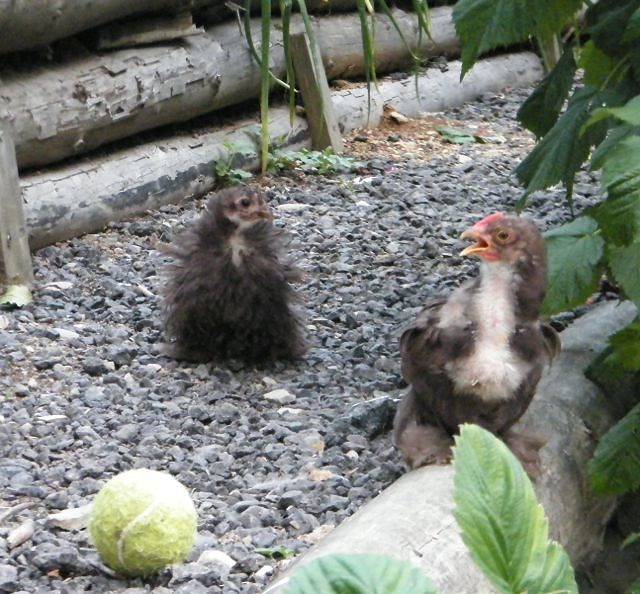|
Everynow and again I set myself a project that saner people would realise is a little bit crazy, maybe a touch ambitous, and guaranteed to give me sleepless nights... This is one of thse projects. I'm well aware that's just a little black swatch of handspun, it's however the start of a much, much larger project. I have lusted after this dress at every fibre show I've been to this year. I could never afford to do it in commercial yarn, however I have the ability to spin my own, and after all, if I'm going to knit a dress it might as well be in yarn I love. I took some fleece from my friend Katharine's flock. It's a Black Welsh Mountain/Gotland cross, I love this wool, long, shiny with a nice crimp. Add in some of my hand dyed silk and you've got the makings of a very special yarn. To start off with I just did a little sample on hand cards and with the drop spindle. Just to test the colours and check the prickle factor. I have no intention of ever wearing a knitted dress next to my bare skin, if it's cold enough for that much wool then I'll want tights and long sleeves on as well. I was ok with it not being butter soft, after all this is going to be a lot of work, I want something that isn't going to pill and start to wear out with in hours of wearing it for the first time. It's not exactly the same as the finished blend, or yarn, but did the job. Next up came the scales, and properly measured out batts. They're going to be 20% silk (10% of each colour, a lilac and a grey), 80% wool. Then I spun a sample, the yarn in the pattern says Sport weight, but I'd handled the recomended yarn and knew that it was more like a DK so aimed for slightly thicker. Rather handily 2 ply DK weight is my default yarn...
I kept back some singles from that sample spinning, that way I can check my spinning against them and hopefully stay consistent. The rest I plyed, and knitted up in to a swatch, just to check I was going down the right thickness path. Once washed I could do some measurements, and the guage is about right. Not perfect, but I can fiddle around with needle sizes, and as I'm between sizes in the pattern I can do some maths to make sure it's right once I've got my skeins of finished yarn. There's rather a lot of spinning to do between then and now though... Meanwhile I have a pile of scrummy batts to spin up, I love how the bounce of the wool ripples the silk. I've spent most of the last week working on the caravan. All the dyeing is done in the kitchen of the static caravan, we primarily got the caravan when we moved in as extra accomodation for family and guests, but it's also come in useful for storage. Over the past couple of years I've slowly filled it with everthing associated with HilltopCloud. It's where the extra undyed fibre lives, the display stuff for shows, extra drum carders for workshops, cardboard boxes for the spinning kits, stock I'm building up for a show, and anything else I don't have room for in my barn. It was still arranged in a standard static caravan format, 2 bedrooms, minute kitchen, compact bathroom, and a seating area with a huge TV unit. Most of the fibre was piled up on the seating, and on the double beds, and the kitchen was tiny, making dyeing hard work. This summer I decided to do something about the lack of space and less than ideal layout, and knew I had a bit of a gap between Fibre East and the next show (Yarndale at the end of September). Here's the start of the work, we'd already taken off the cupbaord doors, but you can see how tired the kitchen looked, and the lack of space. Here's all the units removed, and the fridge. The cooker stayed in place, partly to avoid complicated gas pumbing problems, and I'd worked out a layout where it didn't need to move. The wall to the right is the bedroom wall and that was next to come out, opening up the space. Behind this is the other bedroom, that's stayed in place so we do still have a spare bed if we need it. As ever with these jobs the dogs tried to be helpful, mostly by lying under your feet as you were battling a particularly awkward bit. Gwen in the end worked out that under the table was the safest place! Here's the small mountain of wood we removed, a kitchen, the TV unit, part of a wall, and all the bedroom furntiture. And here's the finished project. A stainless steel workbench at the pefect height for me, sealed on to a splashback so it's easy to clean. Wipe down metal shelving for mixed dyes, and all the other bits and pieces, proper shelving for me to organise powdered dyes. Much better than a tired looking chipboard TV unit, with a wardrobe that was never used. Here's the other end, the mini sink is gone and in it's place a full size sink wth proper draining board. The spin dryer can now drain directly in to the sink, instead of having to sit on the floor and emplty in to basins that inturn have to be emptied. In place of the second bedroom with it's lumpy mattress that filled the entire room there's proper shelving. I've also taken up all the old lino. It had holes in it, and the roof is no longer completely water tight. In a few place we peeled back the lino and found that the roof had seeped water down the side panels of the walls and then sat in puddles rotting the chipboard of the floor. This way I'll spot leaks, and we can fix them, and the floor will stop rotting. The blue floor paint is rather bright, but I'll soon get it dirty, and it was leftovers, so therefore free! And at the other end, there were seats under the piles of fibre, who knew! I also found my blocking wires, I've been playing hide and seek with them for the past couple of months. Also just in shot is the brand new lighting, gone are the moulded glass shades and dim bulbs and in their place are some spot lights, this winter I won't be peering through the gloom anymore.
It's not been a cheap project, but well worth it in terms of saved time and greater productivity. I also no longer need to worry about gaps in the chipboard soaking up spillages. I've now got the space to do larger dyelots, and fibre with longer colour runs. Most of the furniture is from Ikea, the sink unit, table for the spin dryer and all the shelving, as was the lighting. For what I wanted there were by far the cheapest I could find. The longer table is a stainless steel catering table, with a splashback made from a piece of perspex cut to the same length. The first dyeing starts tomorrow, Yarndale is at the end of September, and I'm also planning a week's holiday between now and then. The timing of this post seems rather apt. I'm in the middle of converting our static caravan in a custom dye studio. I've been using it for my dyeing for the last 2 years, and finally decided to knock out some walls, the minute caravan kitchen, and the TV unit in the living space and install stainless steel workbenches, and a proper sized sink. In doing so I've had to clear out wardrobes and cupboards and came across the stuff that I'd shoved in the caravan when I came to Wales 3 years ago. At the time I didn't know what I wanted to do in the future so I kept nearly everything, boxes and boxes of teaching resources and books that I'd accumulated over 3 years. Ironically most of it was only used once, lack of permanent classroom space in all of my schools meant that once I'd used a resource I had to store it at home, so it wasn't in school for when I wanted to use it next... Now 3 years on I won't be going back to teaching anytime soon, and if I do most of my resources will be out of date as the government seem incapable of leaving a curriculum/examination system in place for longer than 2 years. I need the space, and nothing was irreplaceable so it's all gone, to the charity shop, in to recycling, or the bin. So after saying goodbye to a school of one kind, I found myself this summer in a school of a very different sort. I'm a member of a local Guild of Weavers, Spinners and Dyers. If you do spin, and you're not a member of a local guild I recommend you check them out, you can find a full list of guilds on the national association website. I won't lie, it took me 2 attempts to find a guild who were a good fit for me, and the average age of most guilds is above 50, but they're a great place to learn new skills, exchange ideas, and be exposed to new crafts, and borrow more expensive equipment like wool combs and drum carders. I know there are lots of younger spinners out there and it would be great to see more of them at guild meetings. One of the things the association organises is a bi-annual summer school. They take over a university/college campus for a week, and run week-long workshops with expert teachers. The list of workshops is varied, and it's a chance to explore a given subject over a longer period of time. My busy summer schedule meant that I couldn't go to the summer school as a student, but I was invited to the trade fair at the end of the week, and also had a chance to look round the classrooms to see what the students had been doing. (Photos taken on my phone, so please excuse the quality) This class was based on collapse weaving, you weave the fabric, and then when you wash it the pleats and folds activate and you end up with beautiful 3D fabric. This class explored natural dyeing, the range of colours, and the brightness of the colours was very impressive, no sludgy greens to be seen! This class was on tapestry weaving, there was some beautiful work, including some very clever 3D additions, I'd love to see this 4 seasons piece finished. These were skeins from a class focusing on spinning short fibres, lots of chance to try unusual fibres, with expert tuition on how best to spin them. This class was all about making up lengths of handwoven cloth, tailoring is such a tricky skill, and handwoven cloth is irreplaceable so it was nice to see it being put to use. Finally the class I liked best, they'd spent a whole week dyeing with madder, using historical recipes, testing the effects of different water, trying different techniques, but they'd been wonderfully methodical about recording the results. Using the whiteboard walls in the classroom to detail the techniques, ask further questions, and attaching samples. As a visitor you got a real sense of how the class had worked, and as a scientist the methodology really spoke to me!
After Woolfest, I decided I was to treat myself. For ages I'd been looking at the new Bliss wheels, made by Louet forWoolmakers. The clean lines are just what I like in a wheel, I'm not a fan of wheels trying to look old when they're brand new. It was also single treadle, with nice big bobbins, and a very sensible price. It arrived a couple of days before Fibre East, and was taken with me to spin on over the weekend. I've had a bit of a play on it since then and these are the first finished skeins. They're Shetland, dyed by the lovely Amanda from MandaCrafts. Even though I have more fibre than I can shake a stick at, I do enjoy spinning things from other dyers. They stock different fibre to me, and have different colour palettes. It's a bit like cooking, sometimes it's just nice to eat something you've not cooked for yourself!
This is my default DK weight, nothing fancy, nothing technically challenging, just a chance to see how the Bliss spins, and to run it in. I also wanted to see how much I could fit on a bobbin, the big skein is a whopping 145g, so the bobbins will hold a huge amount. The wheel itself spins beautifully, there's lots to like about it, and very little that I'm not so fond of. One of the big plus points in the price, until September 1st they're available for just over £200 including delivery. You do have to assemble the wheel yourself, it comes in a tiny box, but they provide the screwdriver and it wasn't hard. I love that the hooks are properly offset, you can fill a bobbin really evenly as the hooks on opposite sides of the flyer don't line up perfectly. a great many more expensive brands (cough Schacht!) don't bother to do that with their flyer. (ETA it might be that the newer Schacht flyers do now come with offset hooks, mine is 25 years old and doesn't) It's got sealed bearings so the only thing that needs oiling is the treadle, and the bobbin shaft. As I've already said the bobbins themselves are huge, they dwarf the standard Ashford ones. The bobbin storage itself is really good, I refuse to call it an in-built Kate as it's not convenient to ply from, though it's possible to use it that way. The bobbins also have a little slot you can use to poke your leader through so you don't need to knot the leader on. It's a nice little touch and shows someone has thought about the little details. The ratio's are excellent, the slowest at 1:6.5 rivals the slow ratio on my art yarn wheel, and the orifice is nice and large so it would work well for spinning thicker or more textured yarns. The fastest ratio is 1:18.5, which is faster than the standard ratios on my Matchless, it rivals what I achieve with the super high speed whorl, and it feels fantastically fast. They also supply an orifice reducer for spinning finer yarns and reducing the vibration as the yarn passes through the orifice. There are another 2 ratios in between those so you're covered to spin anything from bulky to laceweight without having to treadle like a mad woman, or battle to draft fast enough. My only minor dislike is the Scotch tension, it was changed from the test wheels that were sent out, and I still don't think it's quite right. You can't do fine adjustments to the tension very easily, and if you're not careful you risk catching the end of the flyer on the non-spring side of the tension band. In a wheel with so many clever and thoughtful touches it just doesn't quite sit right, and I can't help but wish for a slightly more elegant system. The Bliss definitely attracted a lot of attention while I was out and about at both Fibre East, and the guild summer school. Quite a few people spun on her and everyone was impressed with the smooth spinning, some weren't keen on the looks, but everyone was very impressed with the value for money. At £200 you get a lot of wheel, and quite a few experienced spinners who teach were considering getting one as a teaching wheel. Woolmakers are doing that very continental thing of having a month off for a summer holiday right now, so you can't place orders until they get back on August 19th. I think the Bliss might get a lot of use over the next few months, not least because I'm going to have my Matchless set up to have a go at the Longest Thread for 2015. The chicks are growing up fast, their Mm has decided she's had enough of looking after them and for a while bedtimes involved much confusion for everyone involved. The main flock sleep in the large house, and the chicks and mum had a temporary box to live in, with the intention that when they were older they'd all move in to the main house. Mum however has decided she's going back to living in the main house at night. Cav did try to follow her, but the other hens were having none of it and made their feelings on the matter very clear. The chicks were 7 weeks old so a bit young to stand up for themselves and establish their place in the pecking order, so now have the box all to themselves at night. For a while night times have been rather confusing, the chicks couldn't understand where their Mum had gone to, this is Cav on top of the chicken shed, calling for his Mum. Not the clearest photo, but it was dim light, and the little blighter never stays still for a nano-second. This is slightly clearer and gives you a real idea of how ridiculous his quiff is, in the wet weather we've had recently he's ended up looking very bedraggled. This is Cav trying to follow his Mum and gives a real sense of the constant blur of motion, he's never still, always on the go. He also has the longest neck! And finally, because Cav does tend to hog the limelight, and bully his siblings here are the other 2. Now named Froome (the smooth one) and Wiggo (the frizzle). Poor Wiggo looks like an example of what happens when you plug a chicken in to an electric socket! They're much less outgoing than their bigger sibling, but still very cute.
|
Archives
January 2024
Categories
All
|
Hilltop CloudHilltop Cloud- Spin Different
Beautiful fibre you'll love to work with. Established 2011 VAT Reg- 209 4066 19 Dugoed Bach, Mallwyd, Machynlleth,
Powys, SY20 9HR |




























 RSS Feed
RSS Feed


